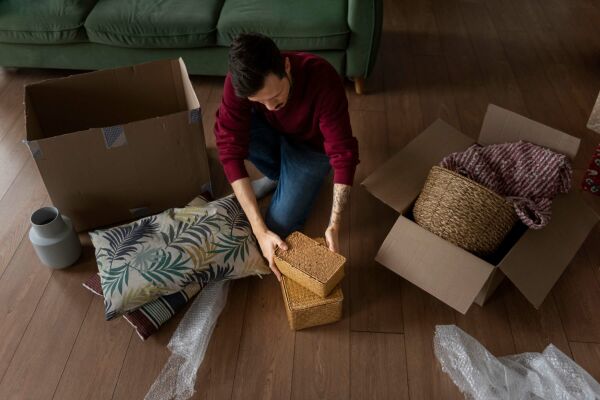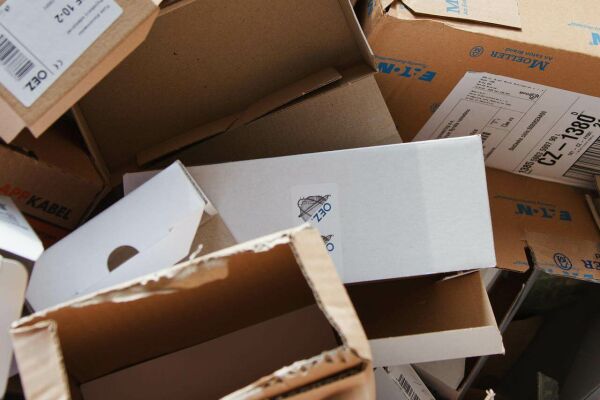Moving is never easy, but let’s face it—some items you have in your home are easier to pack and move than others. When you’re planning out a move, knowing what’s going to be difficult to transport before you start packing is always helpful, especially if you’re moving long distance. Identifying difficult-to-move items early on can help you make a plan for these things, whether you need to ship them separately, make special provisions with your mover, or leave them behind.
You can probably guess what items are tough to move—things that are bulky, heavy, or fragile, for example—but there are some unexpectedly challenging household items you maybe haven’t considered, especially if you’re moving long distance. Whether you’re hiring movers, shipping your stuff, or DIYing your move, you may be better off taking extra precautions or hiring some help for these items:
- Plants
- Pets and their habitats
- Musical instruments
- Artwork
- Bed frames & mattresses
- Grandfather clock
- Exercise equipment
- Sculptures
In this post, we’ll start by taking a closer look at what makes an item difficult to move, then we’ll dig into these eight items and offer our advice for how to move them. Let’s begin.
What Makes An Item Difficult To Move?
The most difficult items to move are difficult to move for a few different reasons:
- Fragility: Delicate and intricate items are challenging to move because they can be damaged easily if they’re not properly packed and transported.
- Weight: Heavy items are difficult to lift and carry, and they risk damaging other items—and your home—if dropped.
- Size: Large, bulky, or oddly shaped items can be hard to pack, or difficult to get a grip on and carry, making them challenging to transport.
Before you pack up a difficult-to-move item, take the following steps to simplify the process as much as possible:
- Measure door frames, hallways, and stairwells so you can ensure the item will fit through the pathway out of the old home and into its new home.
- Get the appropriate equipment to make moving them easier. This can include tools like moving straps, a dolly, moving blankets, and floor sliders.
- Prepare and pack the item properly. Remove and disassemble any pieces that can be removed. For appliances, disconnect them from supply lines, empty or drain them, and clean them thoroughly.
How To Move The Hardest-To-Move Items: The Fragile Stuff
Fragile items are difficult to move because they are breakable or easily damaged. This can include:
- Plants
- Pets and their habitats
- Musical instruments
- Artwork
1. Plants
Plants are delicate living things. They are sensitive to temperature, light, and humidity fluctuations, and they need water, sunlight, and care, so you can’t just put them in a box for two weeks and hope they’ll survive the move. (Spoiler alert: they won’t).
All of these factors make it challenging to pack and move plants, and you’d be hard pressed to find a moving or shipping company that will even bother attempting. When it comes to plants, you’re usually on your own and you may be better off rehoming them and buying new plants at your new house. However, we understand that you may be attached to some of your plants and unable to part with them, so just be careful during the move. The shorter the distance between your old and new homes, the better the chances are for your plants.
Tips for transporting your plants:
- If they’re not already in plastic containers, consider re-potting your plants into plastic containers. They’re lighter and will make the plant easier to transport.
- Trim back any unnecessary foliage. For some plants, such as a bird of paradise, you can cut them back considerably—think down to the base—as the leaves will completely regrow in the right conditions. Cutting down foliage makes them easier to carry because the plant is much smaller and less likely to fall over. Research your plants to find out which ones can be trimmed back and whether it’s the right season for it.
- Bag or wrap your plants to protect them from temperature fluctuations, keep in humidity, and prevent them from getting caught on things.
- Give them a thorough watering a week before they’re set to move, but don’t water them in the days leading up to the move. This way the soil will be damp enough to sustain the roots while still ensuring they are light and easy to carry. Water them as soon as you unpack them and get them set in place.
- We recommend transporting your plants in your personal vehicle rather than packing them in boxes for shipping. If you do opt to pack them, make sure they’re securely held in place with cardboard and other packing materials, and label the box to indicate that it contains living plants and it has to remain this side up. Also make sure that no boxes are stacked on top of them, which could result in damage to the plant.
- After arriving at your new home, immediately unpack your plants and set them up in a spot with natural light. You should also give them a good soak as they may be in shock from the move. Expect to lose a few leaves and wait a few weeks to repot them if you transferred them to plastic pots before the move.
TSI TIP: For plants in your outdoor garden, consider taking cuttings of your favorites rather than digging up the whole garden. It’ll save you time and they’ll be much easier to transport.
2. Pets and their habitats
Whether you are driving or taking another method of transportation, you should make every effort to bring your pet(s) with you during the move. If that is not possible, use a service specifically dedicated to transporting pets.
When it comes to your pet’s habitats or belongings in the home, some items are easier to move than others. Cat towers can be slightly unwieldy, but some can be disassembled and others are fairly sturdy, requiring no packaging considerations—you just have to load them up and secure them in place. If an item is in poor condition, you may want to save yourself the hassle and donate or throw out your old gear, then buy new items when you arrive at your new home. Your pets may thank you.
For more delicate items, such as terrariums and aquariums, you may need to look at crating these items and using a professional shipping company with experience moving delicate-but-heavy items to help you transport it.
3. Musical instruments
Smaller instruments can easily be moved in their individual carriers as long as they are hard cases, though you may want to bring them with you to ensure proper environmental conditions. Larger instruments require a bit more effort:
- Cellos are large, fragile, and expensive. Lighter than a piano but more delicate, it is recommended that you either drive with the cello or book it its own seat on your flight. This way you can ensure it isn’t exposed to temperature and humidity fluctuations, and that it is handled carefully throughout its journey.
- Drum kits can be disassembled and packed into boxes. To reduce the number of boxes needed, remove the heads and nest the drums inside each other with bubble wrap or foam in between for added protection. This is actually how most manufacturers ship their drums to sellers and customers! For more expensive kits, you may want to invest in hard sided cases specifically built for drums.
- Upright, baby grand, and grand pianos are large, heavy items that are physically difficult to move. Upright pianos aren’t that complicated to move aside from the weight, but grands have grander needs, requiring some disassembly, a piano board, and moving blankets.
4. Artwork
Some artwork and picture frames can be safely packed in a box and transported without incident. Just make sure you pack them securely in an appropriately sized box:
- Measure the length, width and thickness of the picture frame. Add 6 inches to each dimension—this will be the size of the corrugated box you will need later.
- For oil paintings where the painting is exposed, start wrapping the picture frame by placing it between two corrugated sheets about 3 inches wider and longer than the frame. Secure the corrugated sheets with 4-inch-wide stretch banding film or 2-inch-wide box sealing tape. For paintings where the painting surface is covered, wrap the frame in glassine paper, like you were gift-wrapping it, and secure the paper in place using box sealing tape. Before doing this, put Artist’s Tape in an “X” pattern across the glass side of the picture frame. Artist’s Tape is non-acidic and will not leave a stain. This will help contain the glass if it does shatter during transit.
- Wrap the picture frame in two or three layers of packaging foam or packaging bubble material, gift-wrap style, to protect against any impact the frame may experience in transit.
- Wrap the frame again, this time with big bubble (half inch) or one-quarter-inch thick polypropylene foam, so that the end result adds 6 inches of thickness all the way around the frame.
- Secure the bubble or foam with box sealing tape.
- Place the picture frame in the box. The corrugated box, the size of which was determined by the measurements you took earlier in step 1, should be a double-wall container. The double layers of corrugated provide extra rigidity and protection against impact.
- After placing the picture frame in the box, fill any remaining void with bubble material or polypropylene foam.
- Seal the box.
TSI TIP: Always load paintings onto a moving truck standing up instead of lying flat. They are much more likely to sustain damage if they are lying flat. And don’t pack paintings in a space where something could fall onto them.
For larger, delicate, more valuable, or heavier pieces, you will have to take additional steps, including crating and hiring a professional service of some kind.
Need assistance with transporting a special piece? Get an artwork shipping quote.
How To Move The Hardest-To-Move Items: The Big Stuff
Bulky and unwieldy, sizable items are large enough to be difficult to lift and carry, even if they’re light. These items include:
- Bed frames and mattresses
- Grandfather clocks
5. Bed frames & mattresses
Mattresses and bed frames are notoriously tough to move. They can be surprisingly weighty and are often shaped in a way that does not lend itself well to navigating tight spaces like corners, doorways, or stairwells—especially if you have a king-size bed.
Like other heavy items, some people opt not to take their bed with them when moving long distance and instead purchase fresh when they arrive at their new home. If you just got your mattress or it’s a really good bed, you can take it with you. Follow these steps to prepare it for transport:
- Remove your mattress from the bed frame. If you have a king-sized mattress that you have to fold to move it more easily through the house, you might want to fold it in your bedroom, then move it closer to the exit point of the home before you finish packing it in a box.
- Dismantle your bed frame.
- Slide the mattress into a mattress bag. Press as much air out of the mattress bag as you can before you tape it shut to prevent air pockets.
- Seal the mattress bag with packing tape. Tape all open edges, as well as around the mattress a couple of times.
- Slide the bagged mattress into a mattress box.
- Seal the mattress box using packing tape.
- Label the mattress box.
- For easier transportation, you can tie ropes around the box to act as handles.
TSI TIP: Memory foam mattresses should never be loaded or stored in an upright position for more than a few minutes. This can cause the layers to separate, leading to irreversible damage.
For more advice on how to transport your mattress, check out our guide on How to Ship a Mattress Across Country.
6. Grandfather clocks
Full of delicate moving parts on top of being heavy and oddly shaped, grandfather clocks are one of the hardest items to move. In order to safely transport it you have to:
- Disassemble any internal components that can be removed. This may include the glass panels, chains and cables, weights, and pendulum.
- Wrap the items you were able to remove in an appropriate packing material and pack the internal components in a heavy-duty moving box—learn more about this step here.
- Cover edges and corners with bubble wrap and cardboard to protect against dings.
- Pack the body of the clock into a crate, held in place with specially fitted styrofoam.
How To Move The Hardest-To-Move Items: The Heavy Stuff
Heavy items are difficult to carry without professional help. These items usually require disassembly, if possible, or special equipment to physically move. In this post, we’ll take a look at:
- Exercise equipment
- Sculptures
7. Exercise equipment
Exercise equipment is weirdly shaped and is often very heavy—sometimes consisting of literal weights. On top of those challenges, taking exercise equipment apart and putting it back together can sometimes feel like it requires a degree in engineering. Some pieces of equipment can be packed in an appropriately sized box, such as the one it came in—if you still have it. Otherwise, you may need to look at wrapping them in moving blankets or hiring a service to pack it for you, especially for heavier items like treadmills, elliptical trainers, or weight machines.
Learn more about how to pack exercise equipment:
- How to Prepare Your Elliptical Machine for Moving
- How to Ship a Treadmill or Elliptical: Preparation & Cost to Ship
8. Sculptures
Sculptures, especially the very large or heavy ones, often require crating and professional services to move them. Usually that means wrapping it well to protect fragile pieces and using a wooden crate to transport it before handing it off to a company that specializes in shipping artwork and other heavy things.
Got something really difficult to move? We love challenges! Learn How TSI Shipped a 1,400 Pound Bronze Statue 713 Miles in 6 Days.
Conclusion
Whether you’re moving in town or across the country, these are some of the most challenging items to move due to their fragility, weight, and/or size:
- Plants
- Pets & their habitats
- Musical instruments
- Artwork
- Bed frames & mattresses
- Grandfather clock
- Exercise equipment
- Sculptures
Need help with your move? Learn more about our household moves.
Need Help With Hard To Move Items?
TSI specializes in transporting heavy, bulky, and difficult to move items.





